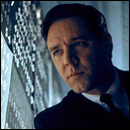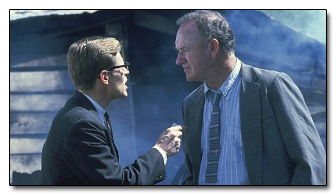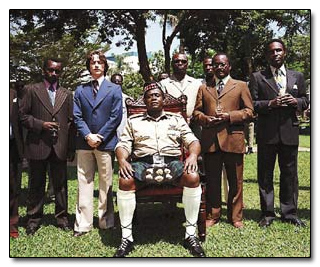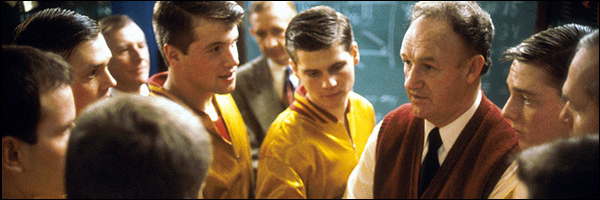6 Movies Based on a True Story (That Are Also Full of Shit)

As we pointed out in the previous installment, it seems the least we can ask of a movie that's based on a true story is that it, you know, be based on a true story.
We don't expect them to stick with every boring fact, but time and time again we find out that the entire point of the story has been totally fabricated. So what's the point of basing it on a true story at all?
We're talking about movies like ...
A Beautiful Mind

The Hollywood Version:
John Forbes Nash was really smart. He was also really, really crazy. When he wasn't working on the concept of governing dynamics, he was having hallucinations of Paul Bettany, seeing hidden messages in newspapers and getting recruited by Ed Harris to break codes for the government, all while running from Russian spies. Which is even weirder when you find out all of that shit happened in his head.

"On your mark. Get set. Crazy!"
The hallucinations became more frequent and, as hallucinations are prone to do, they drove him batshit insane. Fortunately, his loving wife stood by him, Nash committed to a medication regiment and, over time, learned to ignore his hallucinations just in time to win the Nobel Prize in Economics and Crazy in 1994.
In Reality...
There's no denying Nash was both brilliant and afflicted with a bad case of the crazies. But filmmaker Ron Howard was widely criticized for glossing over the life of Nash as well as making up the whole "seeing people who weren't really there" thing. Nash did hear voices, but that's it--his hallucinations were entirely auditory.

"Mr. Howard, 'auditory' doesn't mean he put shoes on his hands, it- OK, you don't care."
The movie completely ignores the fact that John and his wife divorced in 1963, just six years after being married, and never got remarried until 2001 (in addition to the whole insanity thing, the fact that the real Nash dabbled in boning dudes probably didn't help their marriage either). The film also manages to not mention his anti-Semitism, which the real Nash says must have been a side effect of his illness.
At the end of the film, Nash mentions to a friend that he is taking new medication, and he makes a heartfelt speech dedicated to his wife when he accepts his Nobel Prize.
The truth, however, is that both of those things were complete fabrications. Nash stopped taking any medication in 1970, and his continued instability--probably in large part due to that refusal to take medication--led to his not being allowed to make an acceptance speech for fear that he might whip out his dick and start screaming racial slurs at imaginary Jews.
So while the real Nash probably wouldn't have made the best protagonist of a Ron Howard film, we're definitely adding him to our list of "Celebrities Who Need to Get on Twitter."

Remember the Titans

The Hollywood Version:
The opening voiceover in Remember the Titans tells us (in a line they totally stole from James Van der Beek) that in Virginia, football is life. And in Alexandria in 1971, football and real life issues came crashing together when two high schools merged to form TC Williams, the first integrated school in the city.
At first there was racial tension between the white players and the black players, particularly when a black coach who liked to stomp around and scowl a lot (naturally, because he's played by Denzel Washington) was given the head coaching job while the white coach was demoted to a subservient role.

Sometimes racial tension looks like two dudes ready to kiss each other.
But thanks to competitive spirit, a rockin' 70s soundtrack and the good-natured obesity of Ethan Suplee, the team found racial harmony just in time to overcome every Southern stereotype in the book on its way to a dramatic run to the Virginia State Championship.
In Reality...
While TC Williams was in fact the product of several schools in Alexandria merging together to form one big behemoth of a high school, it didn't exactly play out the way it's portrayed in the movie. The key difference being the tiny little fact that TC Williams was formed and integrated six years before the movie takes place.
And though there was racial tension originally, by the time the championship season rolled around it had mostly subsided. No one protested on the first day of school, and while there were heated exchanges in practice, according to the actual players and coaches it was based purely on position battles, and not race.
The whole dramatic run in the middle of the night leading to Denzel's even more dramatic speech about Gettysburg? Yep, totally fabricated.

"Wait, what?"
Despite what Denzel tried to tell us in a big pregame speech in the movie, TC Williams wasn't the only school that had been dealing with some of the racial issues of the day. The Titans weren't, as he declares, the only integrated team in their league. In real life, every single team in TC Williams' league was integrated by the 1971 season.
And what about the big climactic game, where the Titans have to overcome the better team and pull out a ridiculous 80 yard reverse for a touchdown to win? That really happened, right? Actually, they won in a rout, trouncing their opponent 27-0.
In fact, no one put up much of a fight all year for the Titans, who cruised to the championship and finished the year ranked number two nationally. Apparently, watching a team hand out an ass stomping just isn't "cinematic" enough for Disney. Obviously they hadn't seen the sports genre's Citizen Kane, a little film called Rocky III.

The Hollywood Version:
In the midst of the American civil rights movement of the 1960s, a trio of freedom riders made their way along the back roads of Mississippi where, as you might expect on the back roads of Mississippi, they encounter members of the Ku Klux Klan.
Needless to say, the Klan members--which included a police officer--are less than cordial to the boys, promptly forcing them off the road and murdering them without provocation.

"Y'know, those poor bastards probably never saw it coming..."
Enter Willem Dafoe, a by the book FBI Agent (you can tell he's by the book because wears glasses); and Gene Hackman, a guy who thinks that the only way to get the job done is to grab and punch as many nuts as possible. Soon enough, Dafoe learns that Hackman justice is the only justice that works and the boys secure victory over the racist Klan, putting the murderers behind bars one nut shot at a time.

"That's all the balls, there are no more balls, you punched all of the balls!"
In Reality...
The tragic story of the three murdered freedom riders is, sadly, very real.
In the film, upon learning of this tragic event, Dafoe asks for more manpower and the FBI quickly obliges, sending hundreds of agents to help bring the killers to justice. The real life J. Edgar Hoover, while under pressure from LBJ to bring the murderers to justice thanks to a surprising amount of national attention, still wasn't so much inclined to offer up so much help.

"Meh."
You see, in addition to thinking that frilly things made him look pretty, Hoover also thought that the Civil Rights movement was a load of Communist bullshit and wasn't worth the full power of the federal government. Initially, he sent just 11 agents to the town, and not the hundreds depicted in the film.
In the film, the FBI agents swarm into the city hell bent on finding the killers and preventing any further violence; but in reality most of them simply couldn't give less of a shit. Allegedly, the members of the FBI and Justice Department only intervened when absolutely necessary, and in some cases they supposedly stood by while beatings took place right in front of them. Your tax dollars at work, folks!

"I gotta be honest I thought there was gonna be a lot more nut-punching when I signed up for this."
So what really happened? How did the killers finally get brought to justice? Was it all about Hackman-style bully tactics?
We're sad to report that no KKK testicles were actually harmed on the road to justice. Instead, the FBI made their case the same way it's always been done: good old fashioned bribery. The Bureau paid Klan informant James Jordan for information on what happened to the activists, and he obliged. Not as cinematic as the nut-punching thing, we suppose.
The Last King of Scotland

The Hollywood Version:
The Last King of Scotland is not about Scotland at all, but instead chronicles the quirky relationship between brutal Ugandan dictator Idi Amin and a young Scottish doctor.
It follows Nicholas Garrigan, an adventurous Scottish medical school graduate who decides that, being adventurous and all, going to work in Uganda in a missionary clinic might be a good time. He is mistaken.

"No one told me we had to wear ties! This sucks."
Garrigan soon meets Amin, played by Forrest Whitaker and his terrifying eyes, and soon after Amin takes power in Uganda he takes a shining to the young doctor.
After becoming one of Amin's most trusted advisors, Garrigan commits the tiny little faux pas of impregnating one of his wives. One thing leads to another, Garrigan's lover is murdered by Amin's forces, and soon Garrigan is trying to stop the madman Amin by plotting his assassination. It doesn't happen, but Garrigan escapes torture and imprisonment and is able to flee the country and alert the world to Amin's insanity.
In Reality...

For starters, there was never anyone named Nicholas Garrigan. So there's that.
Instead, the character was based on a man named "Major" Bob Astles. He wasn't a doctor. He wasn't from Scotland. And while we've never actually met Astles, we do know he earned the nickname of "The White Rat" from the people of Uganda, and was considered the second most hated man in the country. So there's that, too.
He had worked as an advisor under the regime overthrown by Amin, and soon after Amin took power he was imprisoned and tortured for 17 weeks. And then Amin decided to give him a job, which makes the imprisonment pretty much the most brutal application process this side of The Apprentice.

Unlike the movie's representation of the Garrigan character seeing the light and trying to take Amin down from the inside, Astles remained by Amin's side until the regime was finally overthrown in 1979, when the Brit fled the country before being brought back to Uganda to face criminal charges and become someone's bitch in prison.
Oh, and he never became romantically involved with one of Amin's wives, either. That part of the movie is based in a little bit of fact, it's just that the doctor in question was an African man named Mbalu Mukasa. And Amin's wife died during a botched abortion by Mukasa, who then killed himself.
How can you cut this stuff, Hollywood? This is gold here!
Hoosiers

The Hollywood Version:
Oh, look. Gene Hackman again.
One of the true underdog stories in American sports history, Hoosiers tells the tale of an ornery and disgraced former college coach who takes a job coaching high school basketball in Indiana, where basketball comes in just behind God, family and farming, and well ahead of education and hygiene.
Initially his drill instructor tactics and emphasis on discipline are met with bewilderment and scorn by the townsfolk, who unsurprisingly change their tune when the wins start piling up. The team predictably shocks the basketball world when they take home the title.
In Reality...
The movie's "true story" claim was based on Milan High School and their championship run in 1954. It was not, however, coached by a grizzled guy with a short temper and demands for military-style discipline (Hackman's coach character was actually based on legendary college coach Bobby Knight).

The many faces of Bobby Knight.
In reality, tiny Milan High was coached by 26-year-old Marvin Wood, a former standout player at Butler University who was actually in his second year coaching the tiny high school when they took home the state championship.
More importantly, it also wasn't like Milan surprised anyone with their run in the state tournament. They were a small school, sure, but they'd been on the big stage before. Like, the previous year. In Wood's first season as the head coach, he took the team to the state semifinals, and almost all of the key players from that squad returned the year that they won it all.

Not pictured: A rag tag group of underdogs coached by a Bobby Knight clone.
In the film, the point is made and re-made that there are barely enough young men in the school to make up the team. In reality, Coach Wood wasn't exactly hurting for depth. It turns out 58 kids tried out for varsity that year, and the roster consisted of 10 players all season long. Compare this to the movie where Coach Hackman sends only four players out onto the court, due to a short roster and also to teach a rebellious player a valuable life lesson. And also to prove that he had the biggest dick in the room.
Wood was also married with two kids, so the entire awkward romantic subplot between Hackman and Barbara Hershey was fictional, which means that by showing us a truly brutal kiss between the two actors, the filmmakers were really just trying to make us queasy for no good reason. Mission accomplished, fellas.

The Hollywood Version:
Richard Nixon. He was paranoid, angry, sweat like Patrick Ewing during his televised debates and was basically the most despised president in U.S. history. Oh, and then he ordered felonies to be carried out to help him get re-elected and then covered it up.
Yet no one could ever get an admission of guilt out of ol' Tricky Dick, a schemer and manipulator who was pretty much the presidential version of Snidely Whiplash. But, if the movie Frost/Nixon is to be believed, along came David "Dudley Do-Right" Frost, a British journalist who, through a series of televised interviews, made like Tom Cruise and got Nixon to admit to ordering the code red.

"You can't handle how not-a-crook I am!"
In Reality...
While David Frost was an admirable fop who tried his damndest to get Nixon to admit to his culpability in the whole "stealing information from the Democratic Party" thing, the movie glosses over the fact that it wasn't so much Frost's triumph as it was a Nixonian PR move that led to his finally admitting the role he played and offering a half-hearted apology to the American people.
In the film's version of the final interview, Frost uses his tricky journalistic tactics to ambush Nixon into an admission of guilt. Nixon is trapped, and Frost has won. Huzzah! Pip pip, cheerio and such!

In reality, it turns out that the "apology" was carefully scripted by Nixon and his people well ahead of time. They realized that if he went through the entire interview series without changing his stance, he'd have gained nothing and would be viewed as the "same old Nixon," out to do the classic politician image rehabilitation.
So Nixon delayed the final interview for two months, allowing him to carefully script exactly what he'd say, and how he'd say it. In other words, the whole thing was just another Nixon ploy. When Frost/Nixoncame out earlier this year, many critics were surprised that the disgraced ex-President was the most sympathetic character in the film, and commended for it's daring decision to humanize a monster. Kind of seems less daring when you realize the script was based on a story that unfolded exactly the way Nixon scripted it.

"Nailed it!"
Find more of Jeff's stuff at TheLastGaffe.com.
For more bullshit that people actually believed, check out 11 Movies Saved by Historical Inaccuracy and 7 Clearly Fake News Stories That Fooled The Mainstream Media.
And visit Cracked.com's Top Picks to see the completely true story of how we became the kings of the Internet that is totally not bullshit. Did we mention this story is loaded with boobs?